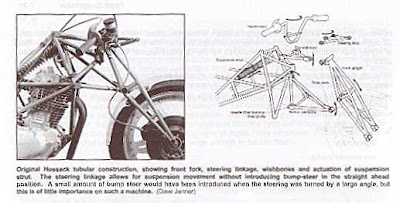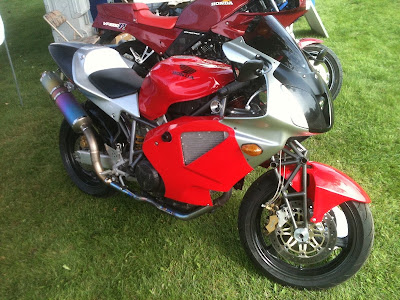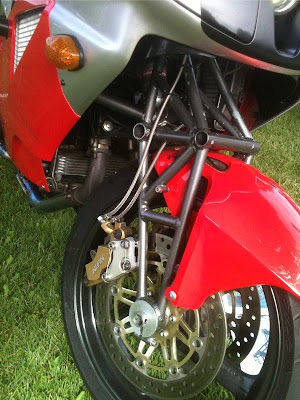But before we get into that, as most of you know, my bike number two is a ZRX1200R. Apparently, earlier in the day there were about 12 of these lined up, one of each color, engine, and tuning flavor. By the time I got there, it was a gaggle of green ones, plus a custom painted black one.

This old Yamaha caught my attention. I suspect the body and the bike didn't start life out together, but who cares, it sure looks good.

I noticed "the project" parked near the Motorcycle Sport Touring Association tent and asked who belong to that bike. The owner/builder is Martin Snuvsnuverink ( I hope I spelled that right) and he was happy to answer my questions.

First, a little bit of history. In 1976, Norman Hossack, in England, developed a double A arm front suspension for a motorcycle. It had the advantage of being light, stiff, and having significantly more anti-dive than telescopic forks. Although telescopic forks still dominate front suspension design, an underfunded, Hossack design bike was able to win five British Single Cylinder championships in the 80's.
I copied the photo above from Tony Foale's excellent book, Motorcycle Handling and Chassis Design. As you can see in the diagram, the Hossack has two forward facing A arms above the wheel and a triangulated fork. The bike steers on heim joints where the fork connects to the front of the A arms. A coil over damper suspends the bike from the fork to the frame. Steering is accomplished through a linkage to the fork.
Some of you may recognize the BMW Duo-Lever front suspension in the Hossack. BMW recognized and copied the Duo-Lever from Hossack.

Martin liked the Hossack design, had some left over Honda parts, and decided to replicate the Hossack design, or at least his version of it. He started with a Honda VTR 1000 Super Hawk. That is a 2001 era bike with a 90 degree V-twin similar in concept to a Ducati.

In this case, the engine, transmission and rear swing suspension were retained. An adjustable geometry Hossack front suspension was made from small diameter tubing, along with a trellis frame to connect the front to the back. The built in adjustment gave the ability to anti-dive, rake, and trail. The light weight tube fork is said to be much lighter and stiffer than telescopic forks. The adjustable coil over damper gives lots of tuning room. The body work and radiators are a combination of RC51 and Super Hawk. Note the side radiators in the fairing which, like the front fairing, are from an RC51.
Martin said that, when he first rode it, he was immediately impressed with the stiffness and control in steering and braking. He tried a range of geometry, including more than 100% anti-dive which makes the front of the bike rise during braking. In the end he settled for about 40% anti-dive and says the confidence in braking is amazing. The lightness of the steering are also said to be remarkable.

This detail shot shows the aluminum cams that are used to adjust the geometry, the billet upper A-arm, the Heim joint that forms the upper ball joint, and the steering linkage going up toward the handlebars.
I am totally impressed with this project. From design to fabrication to tuning, this project is ambitious and professional. Note too that the bike gets ridden and ridden aggressively. You can tell, in part, by the blue stainless steel halfway down the muffler. Thanks, Martin, for trying something different and following your own path. I'm looking forward to a few ambitious projects of my own.
No comments:
Post a Comment